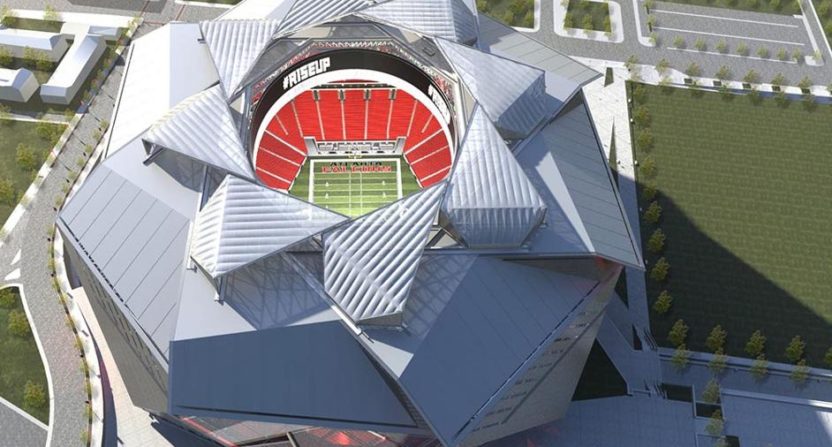The Atlanta Falcons have a new stadium opening for play this fall. Mercedes-Benz Stadium was both privately and publicly financed, with the public money contributed to the project coming in around $600 to 700 million for construction and upkeep of the facility, while total construction estimates (including public and private financing) total north of $1.5 billion.
That’s almost never a good deal for cities, despite the fact that the stadium has already lured events like next season’s college football national championship game, the 2019 Super Bowl, and the 2020 Final Four.
The Falcons have their first preseason game at the stadium in late August, and then their first regular season home game against the Packers on Sept. 17. But the stadium’s retractable roof, perhaps the most distinctive feature of the entire project, won’t be ready by then. The retractable part, anyway:
The retractable roof of Mercedes-Benz Stadium will be in the closed position when the new Falcons stadium debuts next month and for an undetermined period of time beyond that, the CEO of Falcons parent company AMB Group said today.
Steve Cannon said construction delays have the project behind schedule on fully mechanizing the roof.
…
He said it typically takes 40 days to “mechanize” such a roof after its last “contruction move.” Since three more construction moves of the roof are scheduled in the coming weeks, the 40-day clock won’t even begin until after those moves. And Cannon indicated the process could take longer than 40 days because it will be sandwiched around a heavy schedule of events in the stadium.
It’s worth noting that the stadium was supposed to open to host Atlanta United’s debut MLS season earlier this spring, but delays pushed it back even further. So while it’ll be some time before we get to see the weird, kaleidoscopic roof open or shut in the manner of the wormhole on Deep Space Nine (if it was sponsored by Mercedes-Benz), or even something less charitable, it’s also a good time to ask whether retractable roof stadiums are ever a good idea.
They’re certainly nice in theory, much the way a convertible car sounds nice in theory. After all, who doesn’t like fresh air? It turns out NFL teams don’t. This Columbus Dispatch post is from 2015, but remains relevant:
The Cardinals did not play a game with the roof open this season, despite spectacular weather for some late-season games. The Dallas Cowboys opened their roof only once this season while playing only about a third of their games outside since opening the $1.2 billion building in 2009. The Indianapolis Colts have opened their roof at a similar rate as the Cowboys, while the Houston Texans have opened their roof for about 40 percent of their games dating to their founding in 2002.
Plus, with eight home dates a season, where’s the benefit for a stadium built primarily for NFL games? Retractable roofs are hardly a good idea even for baseball, where they can ostensibly prevent rain delays and rainouts, or at the very least provide more temperate conditions for any of the 81 home games each team plays. But for NFL teams, especially stadiums that rely on public money, it seems a wholly unnecessary cost; the extra $25-$50 million might not seem like a lot alongside the typically inflated stadium construction budget, but it still is a lot of money.
And now this roof won’t even be ready, having already had issues that prevented one of the teams for which it was built from using it on schedule. And while it may be a distinctive feature for the project, it’s also just kind of silly.
[AJC]


Retractable roofs make sense in places where the climate has both a season(s) that work for a particular sport and season(s) that don’t. For instance, Miller Park makes sense for Milwaukee, because outside baseball in Milwaukee during the summer is quite enjoyable, but in the spring and fall, it’s too cold. Similar in Seattle; the rainy season can run into June, making baseball up until then a difficult proposition. Toronto (cold) and Miami (rain) seem similarly justified.
As for a lot of the rest, I struggle with the justification. I’d imagine Houston has to keep theirs (baseball and football) closed most of the time. Same with Arizona.
And, though not retractable, the city whose logic will never make any sense to me is Minneapolis. By putting a roof on a baseball stadium, you give yourself the chance to avoid cancellations and bring in fans from across the region with no fear of a rainout (this has worked wonders for the Brewers). And by keeping a roof off the football stadium, you potentially give your team a competitive advantage weather-wise against southern teams unfamiliar with the conditions. So you put a roof on the baseball stadium and leave the roof off the football stadium, right?
Of course not — they did it the other way around, because LOL who cares. Granted, yes, they made the football stadium such that you can play baseball in it, but not in a setup conducive to the Twins.
Millions of dollars does not necessarily equate to intelligence.